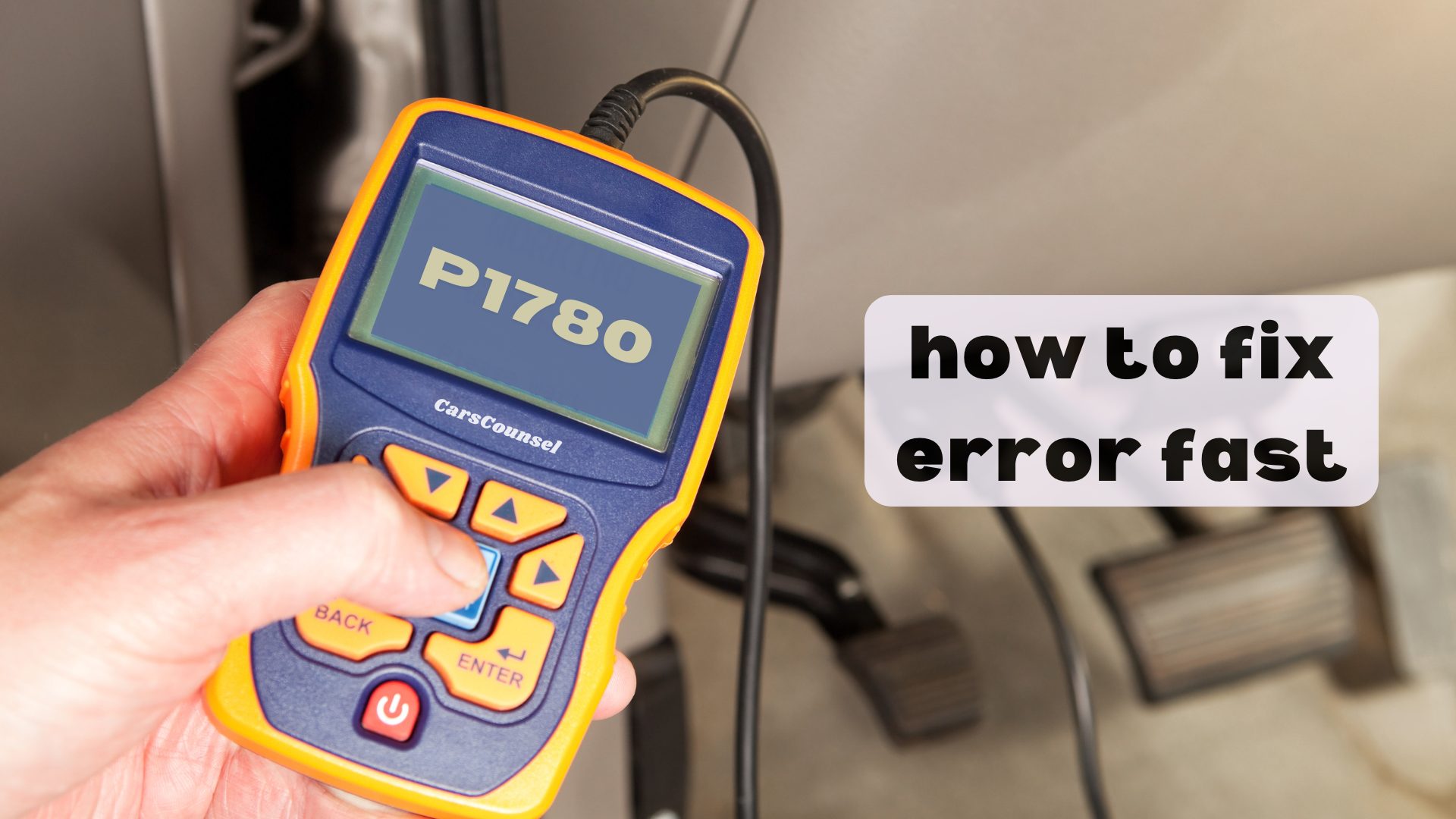You’ve come across the P1780 code and need a quick fix, but where do you begin?
First, it’s important to understand what this error means and the symptoms your car might show. This code often points to issues with the transmission control switch or its wiring, so those are the first things you should check.
Using an OBD2 scanner can help confirm the problem and identify any related OBD2 issues.
Before diving into repairs, make sure you know the exact steps to diagnose and clear this code efficiently, so your car runs smoothly without the error popping up again.

Quick Navigation
Key Takeaways
- Check and Fix Wiring: Look for damaged or corroded wires and connections. Fix any issues to ensure good electrical communication.
- Test the Transmission Control Switch: Make sure the transmission control switch is working properly. If it’s broken, replace it.
- Check Transmission Fluid Pressure: Make sure the transmission fluid pressure is correct. If it’s low, refill or replace the fluid.
- Inspect and Replace the TCM: Look at the Transmission Control Module (TCM) for any problems. If it’s not working right, replace it.
What Is the P1780 Code
What does the P1780 code mean for your vehicle?
The P1780 code points to an issue with the transmission control switch circuit. This code is part of a group of problems related to transmission control. When this code shows up, it means the transmission isn’t sending or receiving the right signals to the Engine Control Module (ECM), which messes up your car’s ability to change gears.
Here’s a simple rundown of the P1780 code:
It can be set off by bad switches, broken wires, or problems with the Transmission Control Module (TCM). To fix it, first, check the transmission control switch and the related wiring for any damage. Then, look at the TCM for any issues.
Fixing these parts can usually clear the P1780 code, helping your transmission work properly again.
Symptoms of P1780 Code
When the P1780 code shows up, you’ll notice several signs indicating there are issues with your vehicle’s transmission control switch circuit.
First, you might have problems with shifting, like delayed or rough shifts. Your vehicle might also show performance issues such as slipping gears or trouble getting into drive. These problems can come with strange noises when you change gears.
To spot these issues, pay attention to how your vehicle shifts while you’re driving. If you notice anything unusual, it’s crucial to address it right away to prevent further damage.
Ignoring these signs can lead to serious transmission damage, higher repair costs, and poor vehicle performance. Keeping an eye on these symptoms helps you maintain good transmission performance and avoid expensive repairs.
Common Causes of P1780 Code
The P1780 code often happens due to a bad transmission control switch, damaged wiring, or problems with the transmission control module (TCM).
To fix it, start by checking if the control switch is working properly and sending the right signals to the ECM.
Next, look at the wiring to see if there are any signs of damage or corrosion that could mess up the electrical connections.
Finally, test the TCM to see if it has any faults, as a bad module can cause gear-shifting problems.
By addressing these issues one by one, you can effectively solve the problem.
Keeping up with transmission maintenance and fixing electrical issues can prevent the P1780 code from causing bigger transmission problems.
Cars Prone to P1780 Code
Some car models are more likely to show the P1780 code because of their transmission control system issues.
For example, Nissan Pathfinders from 2005 to 2010 often have problems with their Transmission Control Module (TCM), leading to delayed shifting and trouble getting into gear.
Similarly, Honda Accords from 2003 to 2007 often face issues with their transmission pressure control solenoids, causing rough shifting and transmission slipping.
If you own one of these cars, it’s important to get your transmission system checked right away to avoid more serious problems.
Regular maintenance and timely repairs can help keep these issues from coming back and ensure your car runs smoothly.
Diagnosing P1780 Code
To diagnose a P1780 code, start by checking the wiring harness for any visible damage or corrosion. Make sure all connections are secure and that the wires are in good shape.
Next, check the transmission fluid pressure, as low pressure can often cause this code to appear. Inspect and test the transmission control switch and solenoids to ensure they’re working correctly.
Also, check the Transmission Control Module (TCM) for any signs of damage or malfunction. A thorough visual inspection can help you spot any wear or issues.
Following these steps will help you find the root cause and fix the problem effectively. Remember, a systematic approach will save you time and help avoid mistakes, getting you closer to resolving the P1780 code quickly.
Using Diagnostic Tools
Using diagnostic tools like OBD2 scanners can make it easier to find and fix the P1780 code.
First, pick the right tool for the job, such as an OBD2 scanner or a more advanced diagnostic tablet. Connect the scanner to your car’s OBD2 port, usually found under the dashboard.
Use the scanner to read the error codes by following the on-screen instructions. Look for other codes that might be related to the P1780 code. Write down any codes and their descriptions for further review.
Do a visual check of the identified issues. This step-by-step method helps you accurately find the problem, making repairs quicker and more effective.
Clearing the P1780 Code
Clearing the P1780 Code
To clear the P1780 code, first make sure you’ve found and fixed the problem causing it.
Then, follow these steps using an OBD2 scanner:
- Plug the OBD2 scanner into your car’s diagnostic port.
- Turn the ignition to the ‘ON’ position without starting the engine.
- Use the scanner to find the P1780 code.
- Choose the option to clear or reset the code.
After clearing the code, keep an eye on your car for any warning lights or if the code comes back.
If the P1780 code shows up again, you’ll need to take another look at what’s causing it.
Don’t ignore warning lights; they can signal problems that might harm your transmission.
Repairing Wiring and Connections
Begin by closely examining the wiring harness for any damage, rust, or loose connections that might be causing issues with the transmission control switch. Use a flashlight to check for frayed wires or rusty connectors.
If you find any damaged wires, cut out the bad sections and solder in new pieces, making sure the connections are solid. Cover the repaired areas with heat shrink tubing for protection.
For connections, ensure all plugs fit tightly; clean any rusty terminals with electrical contact cleaner. Use zip ties to secure any loose connections.
After completing the repairs, reconnect the battery and start the vehicle to make sure the P1780 code doesn’t show up again.
Replacing Faulty Components
Start by finding and removing the faulty part, making sure you have the correct replacement ready. Check that the new part is compatible with your vehicle model. Follow the manufacturer’s instructions to take out the old part. Put in the new part and ensure all connections are tight. Also, look for any signs of damage or rust around the area.
Here’s a simple breakdown:
| Task | Details |
|---|---|
| Identify Faulty Part | Make sure it’s compatible with your car |
| Remove Old Part | Follow the manufacturer’s instructions |
| Install New Part | Ensure all connections are secure |
| Check Surroundings | Look for damage or rust |
Replacement costs can vary, so think about the quality and warranty options. After installing the new part, clear the P1780 code using an OBD2 scanner and take a test drive to make sure the problem is fixed.
Importance of Timely Repairs
Fixing problems quickly after swapping out bad parts makes sure your car’s transmission stays dependable and helps you avoid pricey fixes down the road. Here are some perks of timely repairs:
- Save Money: Stop small problems from turning into big, expensive ones.
- Longer Transmission Life: Keep your transmission working well for a longer time.
- Better Reliability: Make sure your car runs smoothly and safely.
- Prevent Issues: Avoid sudden breakdowns and the hassle of unexpected repairs.
More OBD-II Codes
Frequently Asked Questions
Can Driving With a P1780 Code Affect Fuel Efficiency?
Driving with a P1780 code can impact your gas mileage. Bad gear shifting makes the engine work harder, which uses up more fuel. Fix the problem quickly to avoid wasting gas and damaging your transmission.
How Does a Faulty TCM Impact Overall Vehicle Performance?
A bad TCM can mess up how your car shifts gears! You might see problems like jerky shifting, gears slipping, and slow acceleration. Fixing it quickly helps your car run better and saves you money on repairs.
What Are the Costs Associated With Repairing a P1780 Code Issue?
Fixing a P1780 code can cost between $200 and $1,000, depending on how serious the problem is. You’ll also need to pay around $50 to $150 for the diagnostics. It’s important to fix any wiring, transmission control module (TCM), or sensor issues quickly to prevent higher costs later. Get a professional to make sure the repairs are done correctly.
Are Aftermarket Parts Reliable for Fixing P1780 Code Problems?
You might think about using aftermarket parts, but there are some reliability issues to consider. Make sure they meet the same standards as the original parts. Do your homework, read reviews, and talk to a mechanic. Using good quality parts can reduce risks and make your transmission work better and last longer.
Can Weather Conditions Influence the Occurrence of a P1780 Code?
Yes, weather conditions can affect the appearance of a P1780 code. Check the wiring for any signs of moisture or corrosion. Use diagnostic tools to find problems caused by humidity or temperature changes. Fix these issues quickly to avoid more damage.
Conclusion
Just like an experienced mechanic, you now have the know-how to fix the P1780 code.
Check the wiring and transmission control switch, verify the code with an OBD2 scanner, and fix any problems you find.
If needed, replace the TCM.
Clear the code and take the car for a test drive.
Remember, fixing issues quickly keeps your car running well, much like a well-tuned orchestra.
Your car will appreciate the prompt attention!

